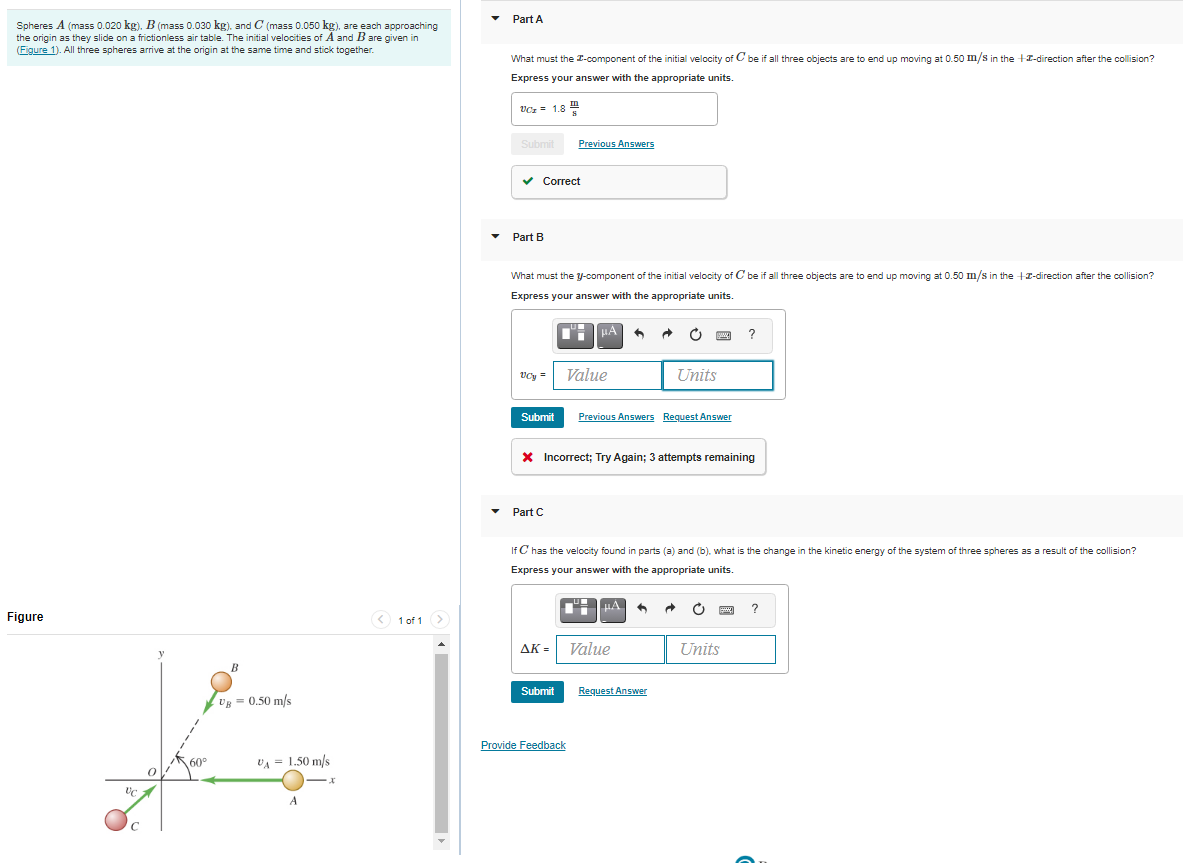Part A Spheres A (mass 0.020 kg). B (mass 0.030 kg). and C (mass 0.050 kg), are each approaching the origin as they slide on a frictioniess air table. The initial velocities of A and Bare given in (Figure 1). All three spheres arrive at the origin at the same time and stick together. What must the I-component of the initial velocity of C be if all three objects are to end up moving at 0.50 m/s in the +I-direction after the collision? Express your answer with the appropriate units. VCz = 1.8 Previous Answers v Correct • Part B What must the y-component of the initial velocity of C be if all three objects are to end up moving at 0.50 m/s in the +z-direction after the collision? Express your answer with the appropriate units. Value Units Submit Previous Answers Request Answer X Incorrect; Try Again; 3 attempts remaining Part C If C has the velocity found in parts (a) and (b). what is the change in the kinetic energy of the system of three spheres as a result of the collision? Express your answer with the appropriate units. Figure < 1 of 1> AK = Value Units Submit Request Answer Ug = 0.50 m/s Provide Feedback 60° vA = 1.50 m/s
Part A Spheres A (mass 0.020 kg). B (mass 0.030 kg). and C (mass 0.050 kg), are each approaching the origin as they slide on a frictioniess air table. The initial velocities of A and Bare given in (Figure 1). All three spheres arrive at the origin at the same time and stick together. What must the I-component of the initial velocity of C be if all three objects are to end up moving at 0.50 m/s in the +I-direction after the collision? Express your answer with the appropriate units. VCz = 1.8 Previous Answers v Correct • Part B What must the y-component of the initial velocity of C be if all three objects are to end up moving at 0.50 m/s in the +z-direction after the collision? Express your answer with the appropriate units. Value Units Submit Previous Answers Request Answer X Incorrect; Try Again; 3 attempts remaining Part C If C has the velocity found in parts (a) and (b). what is the change in the kinetic energy of the system of three spheres as a result of the collision? Express your answer with the appropriate units. Figure < 1 of 1> AK = Value Units Submit Request Answer Ug = 0.50 m/s Provide Feedback 60° vA = 1.50 m/s
Glencoe Physics: Principles and Problems, Student Edition
1st Edition
ISBN:9780078807213
Author:Paul W. Zitzewitz
Publisher:Paul W. Zitzewitz
Chapter9: Momentum And Its Conservation
Section9.1: Impulse And Momentum
Problem 2PP
Related questions
Question

Transcribed Image Text:Part A
Spheres A (mass 0.020 kg). B (mass 0.030 kg), and C (mass 0.050 kg), are each approaching
the origin as they slide on a frictionless air table. The initial velocities of A and B are given in
(Figure 1). All three spheres arrive at the origin at the same time and stick together.
What must the T-component of the initial velocity of C be if all three objects are to end up moving at 0.50 m/s in the +I-direction after the collision?
Express your answer with the appropriate units.
VCz = 1.8
Submit
Previous Answers
v Correct
Part B
What must the y-component of the initial velocity of C be if all three objects are to end up moving at 0.50 m/s in the +1-direction after the collision?
Express your answer with the appropriate units.
Value
Units
Submit
Previous Answers Request Answer
X Incorrect; Try Again; 3 attempts remaining
Part C
If C has the velocity found in parts (a) and (b). what is the change in the kinetic energy of the system of three spheres as a result of the collision?
Express your answer with the appropriate units.
?
Figure
< 1 of 1
AK =
Value
Units
B
Submit
Request Answer
Ug = 0.50 m/s
Provide Feedback
60°
vA = 1.50 m/s
A
Expert Solution
This question has been solved!
Explore an expertly crafted, step-by-step solution for a thorough understanding of key concepts.
This is a popular solution!
Trending now
This is a popular solution!
Step by step
Solved in 4 steps with 2 images

Knowledge Booster
Learn more about
Need a deep-dive on the concept behind this application? Look no further. Learn more about this topic, physics and related others by exploring similar questions and additional content below.Recommended textbooks for you

Glencoe Physics: Principles and Problems, Student…
Physics
ISBN:
9780078807213
Author:
Paul W. Zitzewitz
Publisher:
Glencoe/McGraw-Hill

University Physics Volume 1
Physics
ISBN:
9781938168277
Author:
William Moebs, Samuel J. Ling, Jeff Sanny
Publisher:
OpenStax - Rice University

Classical Dynamics of Particles and Systems
Physics
ISBN:
9780534408961
Author:
Stephen T. Thornton, Jerry B. Marion
Publisher:
Cengage Learning

Glencoe Physics: Principles and Problems, Student…
Physics
ISBN:
9780078807213
Author:
Paul W. Zitzewitz
Publisher:
Glencoe/McGraw-Hill

University Physics Volume 1
Physics
ISBN:
9781938168277
Author:
William Moebs, Samuel J. Ling, Jeff Sanny
Publisher:
OpenStax - Rice University

Classical Dynamics of Particles and Systems
Physics
ISBN:
9780534408961
Author:
Stephen T. Thornton, Jerry B. Marion
Publisher:
Cengage Learning